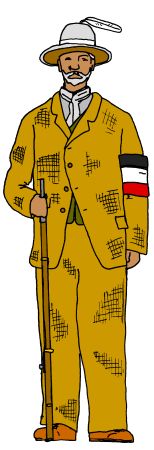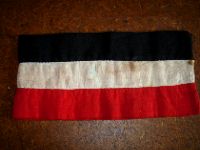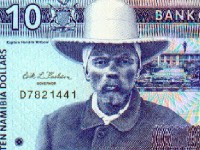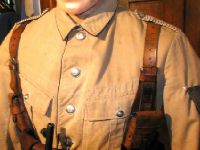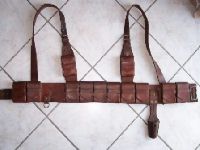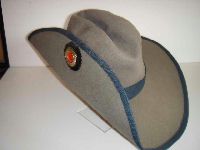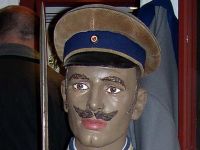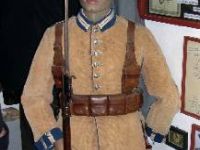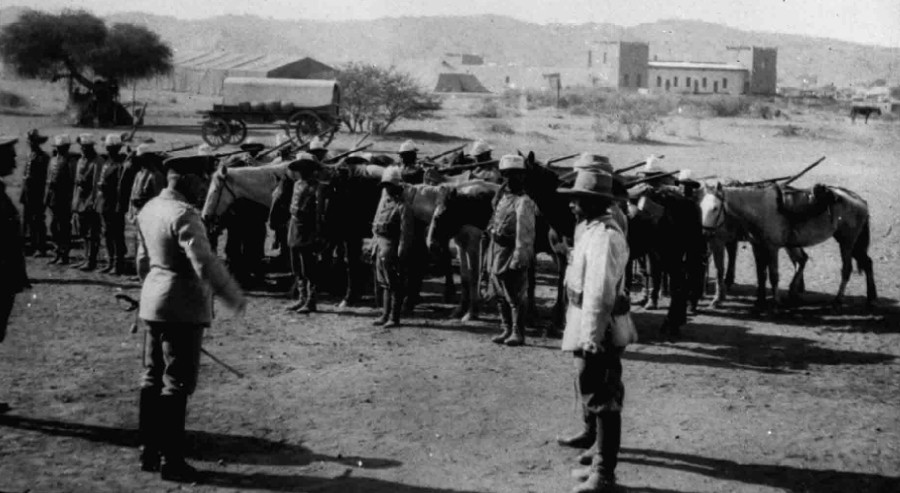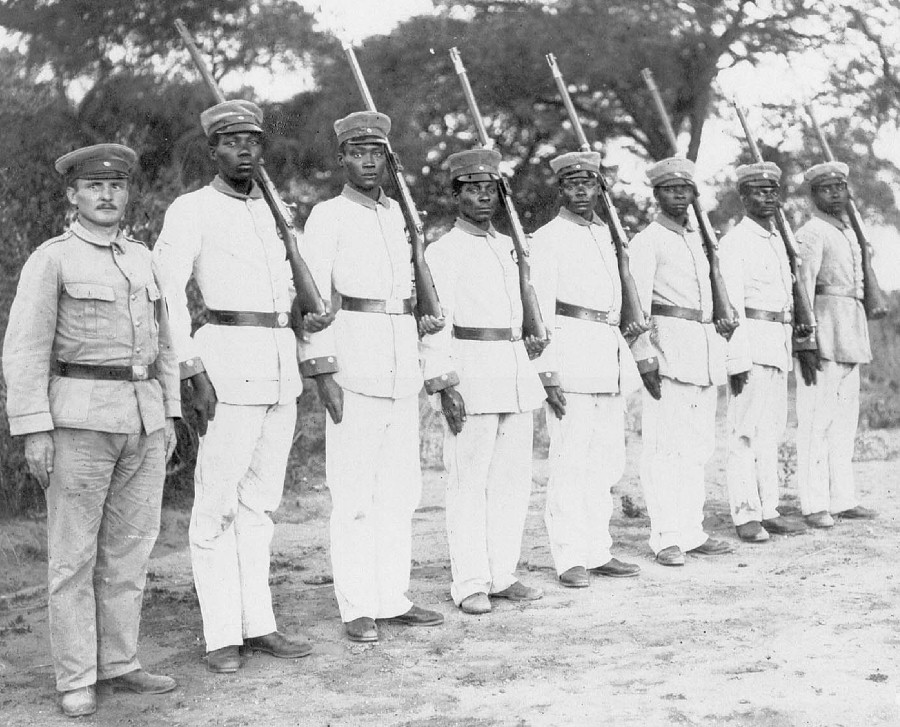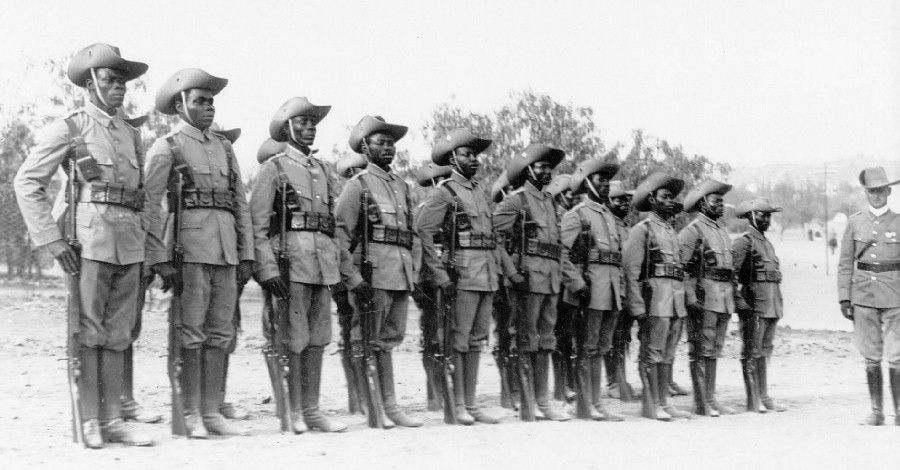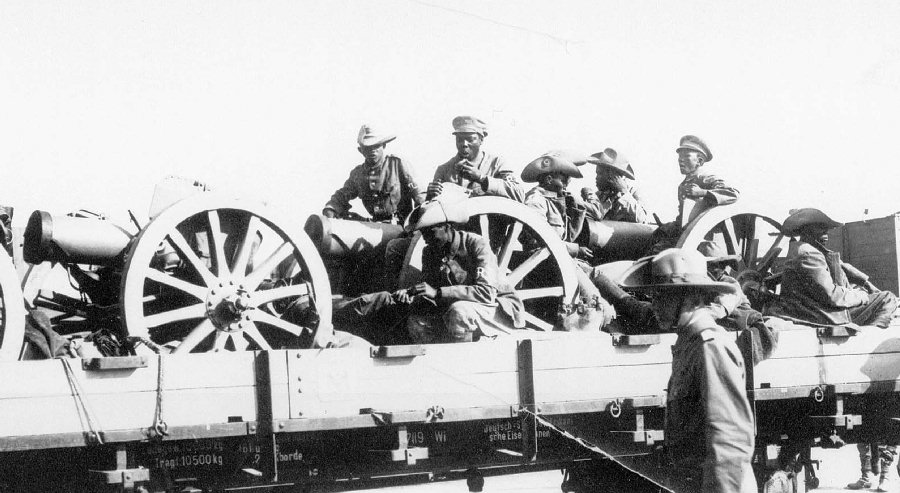Uniforms of African Auxiliary Troops in
South West Africa
The first African tribal auxiliary troops to serve the Schutztruppe of
German South West Africa (such as the Herero and Witbooi Nama) usually wore their
own clothing often with an armband in the German imperial colours on the
left arm. On other occasions the imperial colours were worn as strip
around the hatband, or a sash over the shoulder. Unlike the tribes of German East Africa and Cameroon, the Nama
and Herero of German South West Africa usually wore western clothing after
contact with Boer settlers. From the Boers they also learned guerrilla
warfare tactics and sometimes adopted Dutch names and titles. They were armed with a variety of firearms and often
carried bandoliers of ammunition over their shoulders in the style of
the Boers.Later African auxiliary
troops were issued Schutztruppe uniforms and weapons.
Unlike in German East Africa and Cameroon where African soldiers
had their own design of uniforms, African soldiers in the South
West African Schutztruppe wore the same uniforms as their
German counterparts. These uniforms were however sometimes of an
obsolete pattern and were often stripped of the Schutztruppe
insignia such as shoulder straps and Litzen. While some photographs of units
of African auxiliaries serving alongside the Schutztruppe show
them dressed very uniformly, other photographs show them wearing
mixtures of uniforms and partial civilian dress.
Gustav Frenssen recalls in his
memoirs, "A Narrative of the German
Campaign in South-West Africa" translated by Peter Moor
(available in PDF format at the
US Archive)- "In one corner was quartered a whole
troop of Witboys, hideous looking men with wild, yellow faces.
They had come from the south of the colony to help us, and wore
our uniform and were commanded by German officers."
The Illustrations
Figure 1 is based on a
photograph of Hendrik Witbooi, a Nama Chief in German
Service taken in about 1904. Despite being a
tribal chief he
wears little to distinguish his high ranking status and is dressed
typically for a Nama warrior, although some were noticeably less well dressed
and most carried cartridge bandoliers across their shoulders. The sign of the Witbooi tribe was a white scarf on the hat,
Hendrik also wears the Nama sign of being at war, which
was a white feather in the cap. While in German service
Nama warriors often, though not always, wore
armbands in the German imperial colours as seen here (and see
right).
Hendrik Witbooi (c1835-1905)
was a well educated, multi-lingual Christian born into Nama
royalty. Hendrik succeeded to the title of chief ("Kapitein", after
the Dutch) of the whole Witbooi Nama tribe in 1888 after his father,
Chief Moses Witbooi
was murdered by his rival Paul Visser. Hendrik then had Visser
murdered and united several groups of Nama under his control.
Hendrik initially resisted German
rule but after the defeat of the First Nama
Rebellion of 1893-94, he signed a peace treaty with the
German governor, Leutwein, and became a loyal ally of the
Germans. As such, he provided Nama auxiliary troops to several small German
campaigns and the early phases of the 1904 campaign against the Nama's sworn enemy,
the Herero. In October 1904 however Hendrik and the Witbooi Nama rose up in revolt against the
Germans once again. Hendrik was killed in action in October
1905 but the rebellion lasted several years until it was finally
crushed in 1908. Hendrik Witbooi is now seen as a national hero in
Namibia and his face appears on modern Namibian banknotes (see
right).
Figure 2 is based on a
photograph of a Witbooi Nama Trooper taken in about
1904 after they had been issued with Schutztruppe uniforms. He wears
a Schutztruppe 1896 khaki tunic piped in blue (see right)
with an armband in the imperial colours on the left sleeve,
corduroy riding breeches, Schutztruppe mounted equipment (see
right),
leather gaiters (of a style also seen in Cameroon) and short leather
boots. His hat is a Nama slouch hat with a white Witbooi scarf
or cover on the top and a cockade and hatband in German imperial
colours. He also appears to wear a dark coloured scarf around
his head and neck probably to protect against sandstorms in the
desert.
In the original photograph upon
which this illustration is based, are
several other Witbooi Nama mounted troopers. They all wear various
combinations of Nama and German clothing including the Südwester
(see right) and Kord
Litewka.
Figure 3 is based on a
photograph of an African Police Assistant ("Polizeidiener").
Typically for many photographs of Africans serving with the
Schutztruppe this police assistant wears standard Schutztruppe
uniform (in this case the
Kord Waffenrock and
Südwester hat piped in blue for South West Africa- see right) but stripped of Schutztruppe insignia
such as the collar and cuff Litzen and shoulder straps. He also
wears a red sash to denote he is serving the police.
In the original photograph upon
which this illustration is based, are
several other African Police all wearing Schutztruppe corduroy uniforms
with a red sash over the shoulder. One curiously wears an old
1894 Kord Waffenrock with Polish
cuffs. Some wear Südwester hats and one a Schutztruppe corduroy peaked cap
(see right).
Africans serving in the South West
African police from 1907 onwards began to be issued standard
German Landespolizei uniforms with a red armband with "LP" in
white to replace the sash (see Landespolizei Page).
Figure 4 is based on a
photograph of a Trooper of the "Baster Kompanie"
taken in about 1905. This African soldier, like others in the original photograph
upon which
this illustration is based, is dressed exactly as his German
counterparts. He wears an
1896 Schutztruppe Kord Waffenrock (see right) with blue collar and cuffs,
still retaining the Schutztruppe double white Litzen. He wears khaki trousers
worn loose over his boots and a corduroy field cap again with blue hatband and piping and a
small imperial cockade on the front (see right). He carries
Schutztruppe mounted equipment in brown leather.
Figure 5 is based on a
photograph of a Trooper of the "Kamerun Kompanie"
taken in 1914. Again this trooper wears the same uniform as his
German counterparts. He wears a Schutztruppe 1896 khaki tunic
piped in blue (see right), with matching khaki trousers tucked
into brown leather gaiters and short boots. His headgear is the
Schutztruppe Südwester hat (see right). He also carries
Schutztruppe mounted equipment (see right).
While the Schutztruppe of South West Africa did not
seem to have a shortage of uniforms during the First World War, they do
appear to have suffered from a shortage of horses. Photographs
show the Kamerun Kompanie were only mounted on oxen. |
